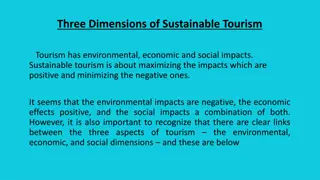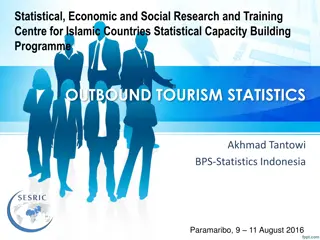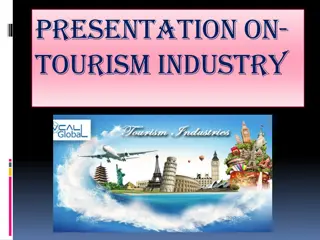Environmental Impacts of Tourism: Balancing Conservation and Development
Tourism plays a significant role in both damaging and preserving the environment. While tourism development can lead to negative impacts like resource depletion, water scarcity, and habitat loss, it also has the potential to raise awareness, contribute to conservation efforts, and fund the protection of natural areas. It is crucial to strike a balance between the economic benefits of tourism and the preservation of environmental resources to ensure sustainable travel practices for future generations.
Download Presentation

Please find below an Image/Link to download the presentation.
The content on the website is provided AS IS for your information and personal use only. It may not be sold, licensed, or shared on other websites without obtaining consent from the author.If you encounter any issues during the download, it is possible that the publisher has removed the file from their server.
You are allowed to download the files provided on this website for personal or commercial use, subject to the condition that they are used lawfully. All files are the property of their respective owners.
The content on the website is provided AS IS for your information and personal use only. It may not be sold, licensed, or shared on other websites without obtaining consent from the author.
E N D
Presentation Transcript
ENVIRONMENTAL IMPACTS OF TOURISM
ENVIRONMENTAL IMPACTS OF TOURISM The quality of the environment, both natural and man- made, is essential to tourism. However, tourism's relationship with the environment is complex - many activities can have adverse environmental effects. Many of these impacts are linked with the construction of general infrastructure such as roads and airports, and of tourism facilities, including resorts, hotels, restaurants, shops, golf courses and marinas. The negative impacts of tourism development can gradually destroy the environmental resources on which it depends. On the other hand, tourism has the potential to create beneficial effects on the environment by contributing to environmental protection and conservation. It is a way to raise awareness of environmental values and it can serve as a tool to finance protection of natural areas and increase their economic importance
ENVIRONMENTAL IMPACTS OF TOURISM Negative impacts from tourism occur when the level of visitor use is greater than the environment's ability to cope with this use within the acceptable limits of change. Uncontrolled conventional tourism poses potential threats to many natural areas around the world. It can put enormous pressure on an area and lead to impacts such as: soil erosion, increased pollution, discharges into the sea, natural habitat loss, increased pressure on endangered species and heightened vulnerability to forest fires. It often puts a strain on water resources, and it can force local populations to compete for the use of critical resources.
ENVIRONMENTAL IMPACTS OF TOURISM DEPLETION OF NATURAL RESOURCES Tourism development can put pressure on natural resources when it increases consumption in areas where resources are already scarce.
ENVIRONMENTAL IMPACTS OF TOURISM Water Resources The tourism industry generally overuses water resources for hotels, swimming pools, golf courses and personal use of water by tourists. This can result in water shortages and degradation of water supplies, as well as generating a greater volume of waste water. In drier regions like the Mediterranean, the issue of water scarcity is of particular concern. Because of the hot climate and the tendency of tourists to consume more water when on holiday than they do at home, the amount used can run up to 440 litres a day. This is almost double what the inhabitants of an average Spanish city use.
ENVIRONMENTAL IMPACTS OF TOURISM Golf course maintenance can also deplete fresh water resources. In recent years golf tourism has increased in popularity and the number of golf courses has grown rapidly. Golf courses require an enormous amount of water every day and this can result in water scarcity. If the water comes from wells, over-pumping can cause saline intrusion into groundwater. Golf resorts are more and more often situated in or near protected areas or areas where resources are limited, exacerbating their impacts. An average golf course in a tropical country such as Thailand needs 1500kg of chemical fertilizers, pesticides and herbicides per year and uses as much water as 60,000 rural villagers.
ENVIRONMENTAL IMPACTS OF TOURISM Local resources Tourism can create great pressure on local resources like energy, food, and other raw materials that may already be in short supply. Greater extraction and transport of these resources exacerbates the physical impacts associated with their exploitation. Because of the seasonal character of the industry, many destinations have ten times more inhabitants in the high season as in the low season. A high demand is placed upon these resources to meet the high expectations tourists often have (proper heating, hot water, etc.).
ENVIRONMENTAL IMPACTS OF TOURISM Land degradation Important land resources include fertile soil, forests, wetlands and wildlife. Increased construction of tourism facilities has increased the pressure on these resources and on scenic landscapes. Direct impact on natural resources in the provision of tourist facilities can be caused by the use of land for accommodation and other infrastructure provision, and the use of building materials. Forests often suffer negative impacts of tourism in the form of deforestation caused by fuel wood collection and land clearing. For example, one trekking tourist in Nepal can use four to five kilograms of wood a day.
ENVIRONMENTAL IMPACTS OF TOURISM POLLUTION Tourism can cause the same forms of pollution as any other industry: Air emissions Noise Solid waste and littering Releases of sewage Oil and chemicals Even architectural/visual pollution
ENVIRONMENTAL IMPACTS OF TOURISM Air pollution and noise Transport by air, road, and rail is continuously increasing in response to the rising number of tourists and their greater mobility. Tourism now accounts for more than 60% of air travel. One study estimated that a single transatlantic return flight emits almost half the CO2 emissions produced by all other sources (lighting, heating, car use, etc.) consumed by an average person yearly. Air pollution from tourist transportation has impacts on the global level, especially from CO2 emissions related to transportation energy use. And it can contribute to severe local air pollution. Noise pollution from airplanes, cars, buses, (+ snowmobiles and jet skis) In addition to causing annoyance, stress, and even hearing loss for humans, it causes distress to wildlife and can cause animals to alter their natural activity patterns.
ENVIRONMENTAL IMPACTS OF TOURISM In winter 2000, 76,271 people entered Yellowstone National Park on snowmobiles, outnumbering the 40,727 visitors who came in cars, 10,779 in snowcoaches and 512 on skis. A survey of snowmobile impacts on natural sounds at Yellowstone found that snowmobile noise could be heard 70% of the time at 11 of 13 sample sites, and 90% of the time at 8 sites. At the Old Faithful geyser, snowmobiles could be heard 100% of the time during the daytime period studied. Snowmobile noise drowned out even the sound of the geyser erupting.
ENVIRONMENTAL IMPACTS OF TOURISM Solid waste and littering In areas with high concentrations of tourist activities and appealing natural attractions, waste disposal is a serious problem and improper disposal can be a major despoiler of the natural environment - rivers, scenic areas, and roadsides. For example, cruise ships in the Caribbean are estimated to produce more than 70,000 tons of waste each year. Solid waste and littering can degrade the physical appearance of the water and shoreline and cause the death of marine animals. In mountain areas, trekking tourists generate a great deal of waste. Tourists on expedition leave behind their garbage, oxygen cylinders and even camping equipment. Such practices degrade the environment with all the detritus typical of the developed world, in remote areas that have few garbage collection or disposal facilities.
ENVIRONMENTAL IMPACTS OF TOURISM The Wider Caribbean Region, stretching from Florida to French Guiana, receives 63,000 port calls from ships each year, and they generate 82,000 tons of garbage. About 77% of all ship waste comes from cruise vessels. On average, passengers on a cruise ship each account for 3.5 kilograms of garbage daily - compared with the 0.8 kilograms each generated by the less well-endowed folk on shore.
ENVIRONMENTAL IMPACTS OF TOURISM Sewage Construction of hotels, recreation and other facilities often leads to increased sewage pollution. Wastewater has polluted seas and lakes surrounding tourist attractions, damaging the flora and fauna. Sewage runoff causes serious damage to coral reefs because it stimulates the growth of algae, which cover the filter-feeding corals, hindering their ability to survive. Sewage pollution threatens the health of humans and animals.
ENVIRONMENTAL IMPACTS OF TOURISM Aesthetic Pollution Often tourism fails to integrate its structures with the natural features and indigenous architectural of the destination. Large, dominating resorts of disparate design can look out of place in any natural environment and may clash with the indigenous structural design. A lack of land-use planning and building regulations in many destinations has facilitated sprawling developments along coastlines, valleys and scenic routes. The sprawl includes tourism facilities themselves and supporting infrastructure such as roads, employee housing, parking, service areas, and waste disposal.
ENVIRONMENTAL IMPACTS OF TOURISM Physical impacts of tourism development Construction activities and infrastructure development The development of tourism facilities can involve sand mining, beach and sand dune erosion and loss of wildlife habitats. Deforestation and intensified or unsustainable use of land Construction of ski resort accommodation and facilities frequently requires clearing forested land. Coastal wetlands are often drained due to lack of more suitable sites. Marina development Development of marinas and breakwaters can cause changes in currents and coastlines. Coral reefs Especially fragile marine ecosystems - suffering worldwide from reef- based tourism developments. Evidence suggests a variety of impacts to coral result from shoreline development, increased sediments in the water, trampling by tourists, ship groundings, pollution from sewage, souvenir extraction.
ENVIRONMENTAL IMPACTS OF TOURISM Physical impacts from tourist activities Trampling Tourists using the same trail over and over again trample the vegetation and soil, eventually causing damage that can lead to loss of biodiversity and other impacts. Such damage can be even more extensive when visitors frequently stray off established trails. Anchoring and other marine activities In marine areas many tourist activities occur in or around fragile ecosystems. Anchoring, scuba diving, yachting and cruising are some of the activities that can cause direct degradation of marine ecosystems such as coral reefs. Alteration of ecosystems by tourist activities Habitat can be degraded by tourism leisure activities. For example, wildlife viewing can bring about stress for the animals and alter their natural behaviour when tourists come too close.
ENVIRONMENTAL IMPACTS OF TOURISM Trampling impacts on vegetation Trampling impacts on soil Breakage and bruising of stems Loss of organic matter Reduction in soil macro porosity Reduced plant vigour Decrease in air and water permeability Reduced regeneration Loss of ground cover Increase in run off Change in species composition Accelerated erosion























